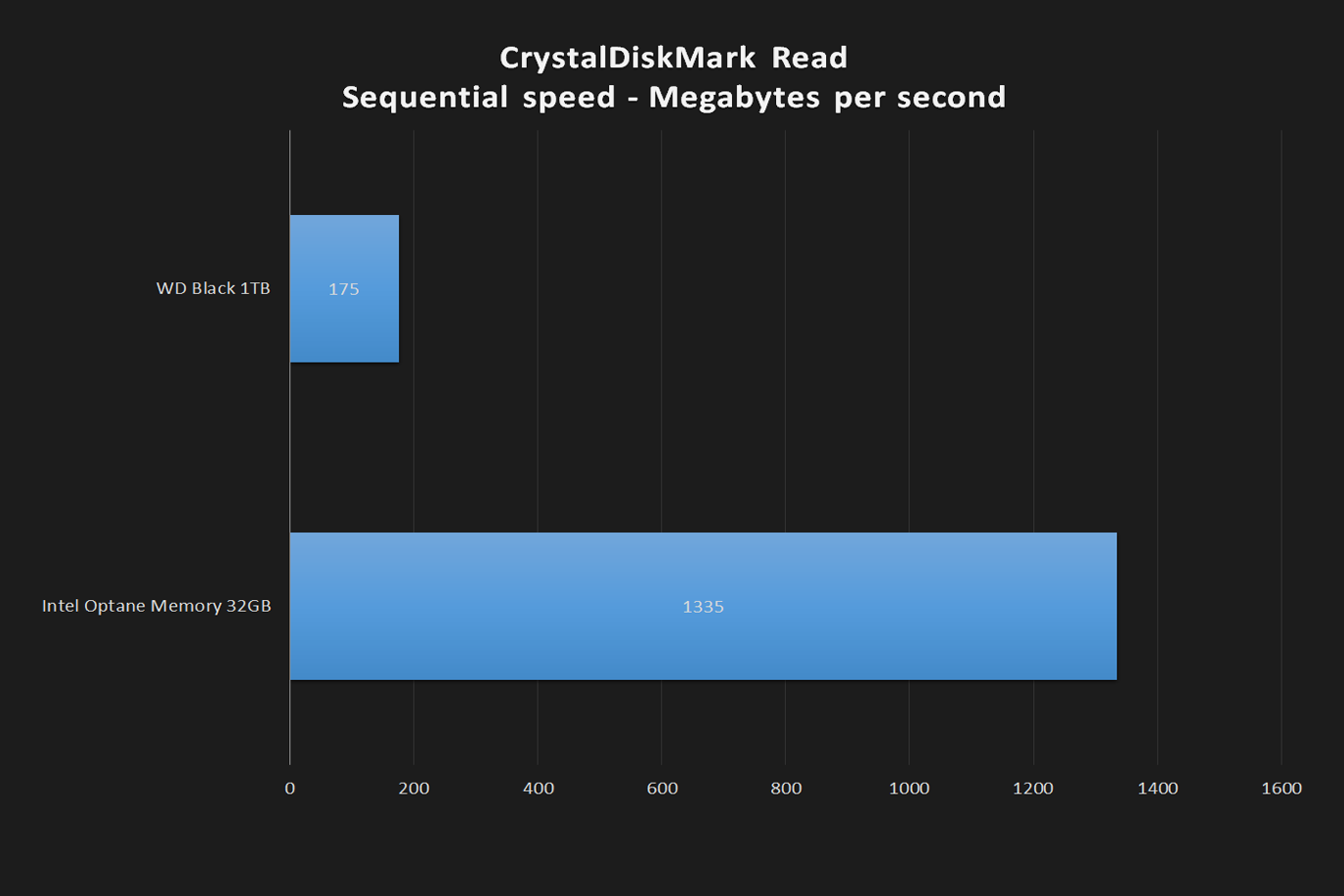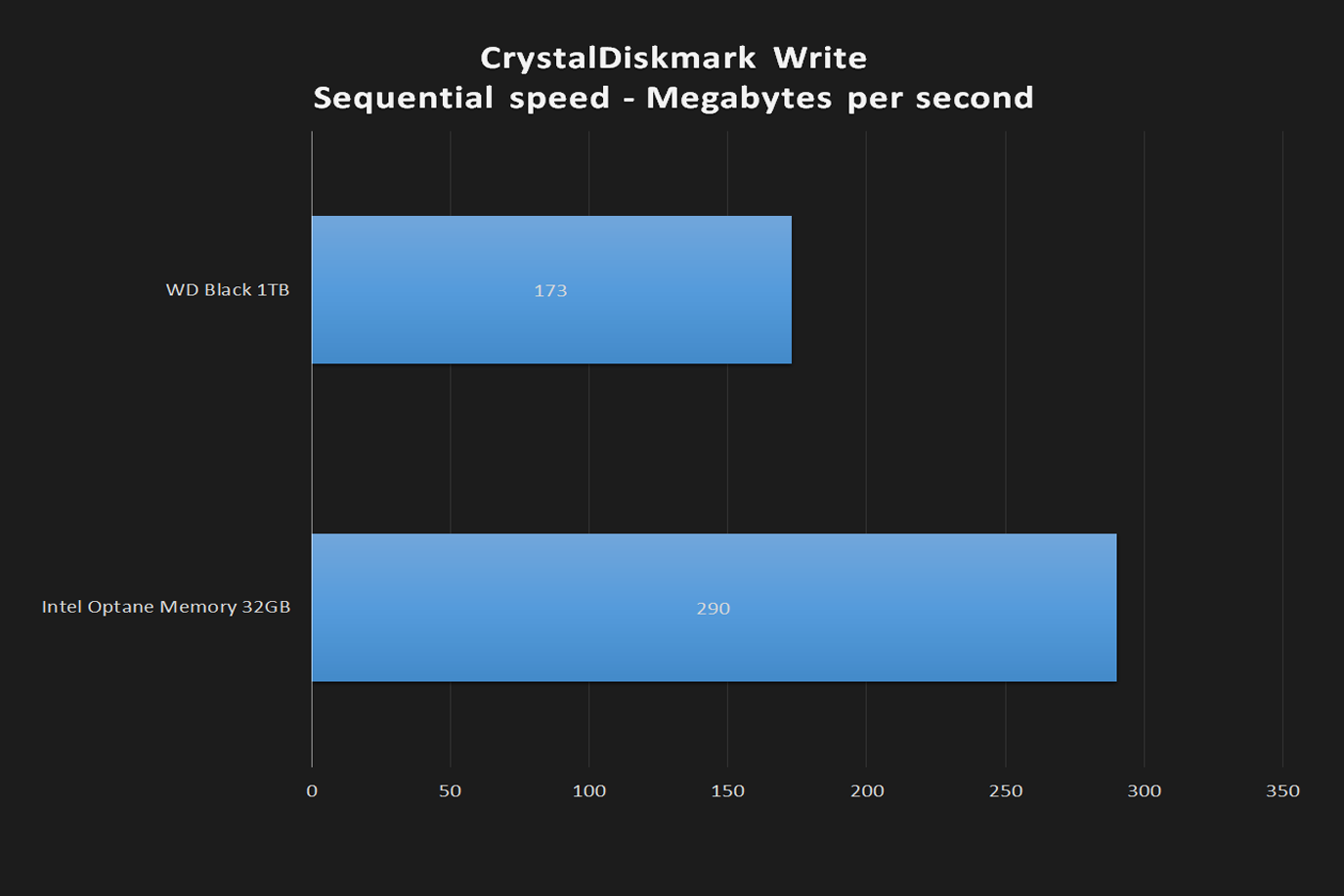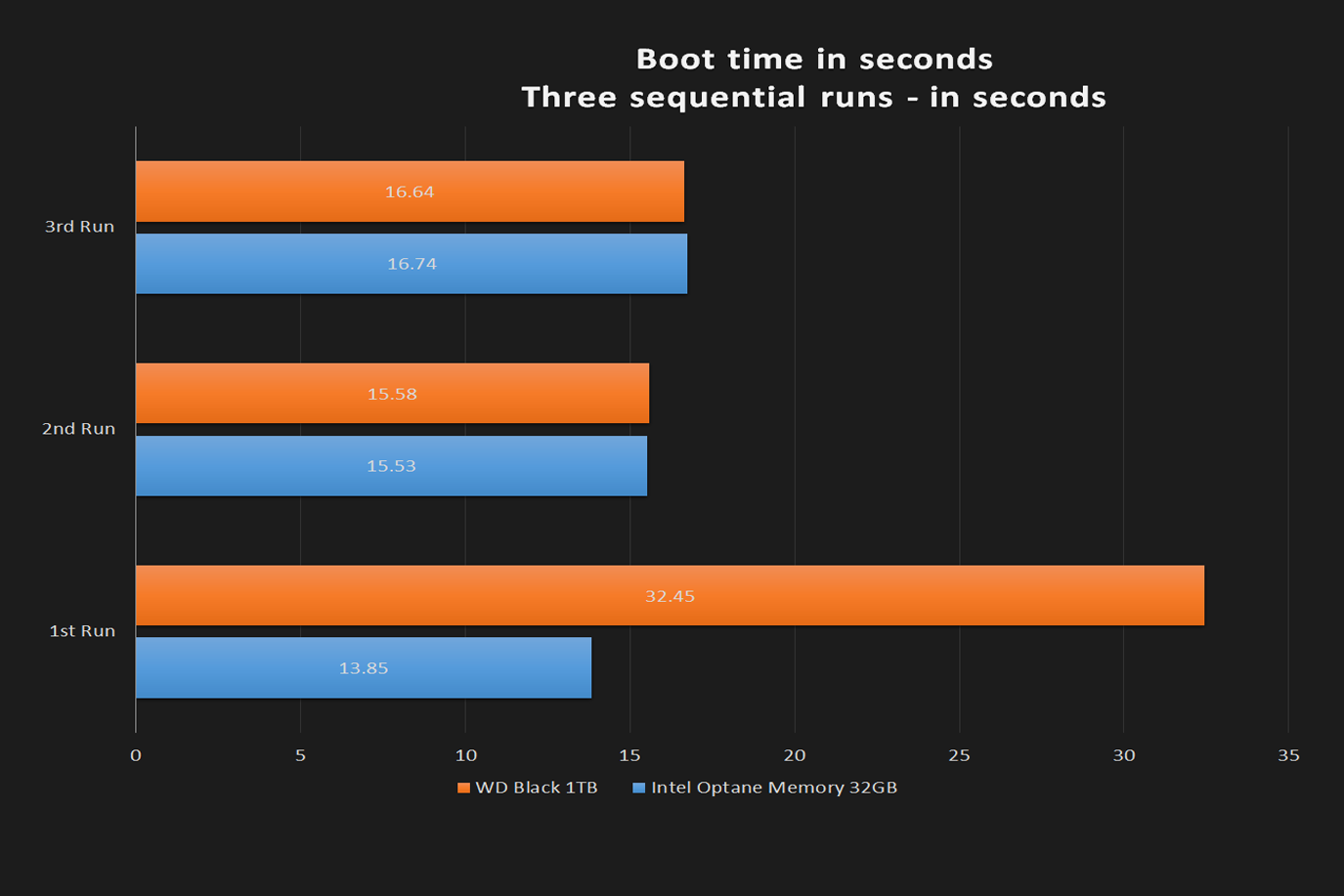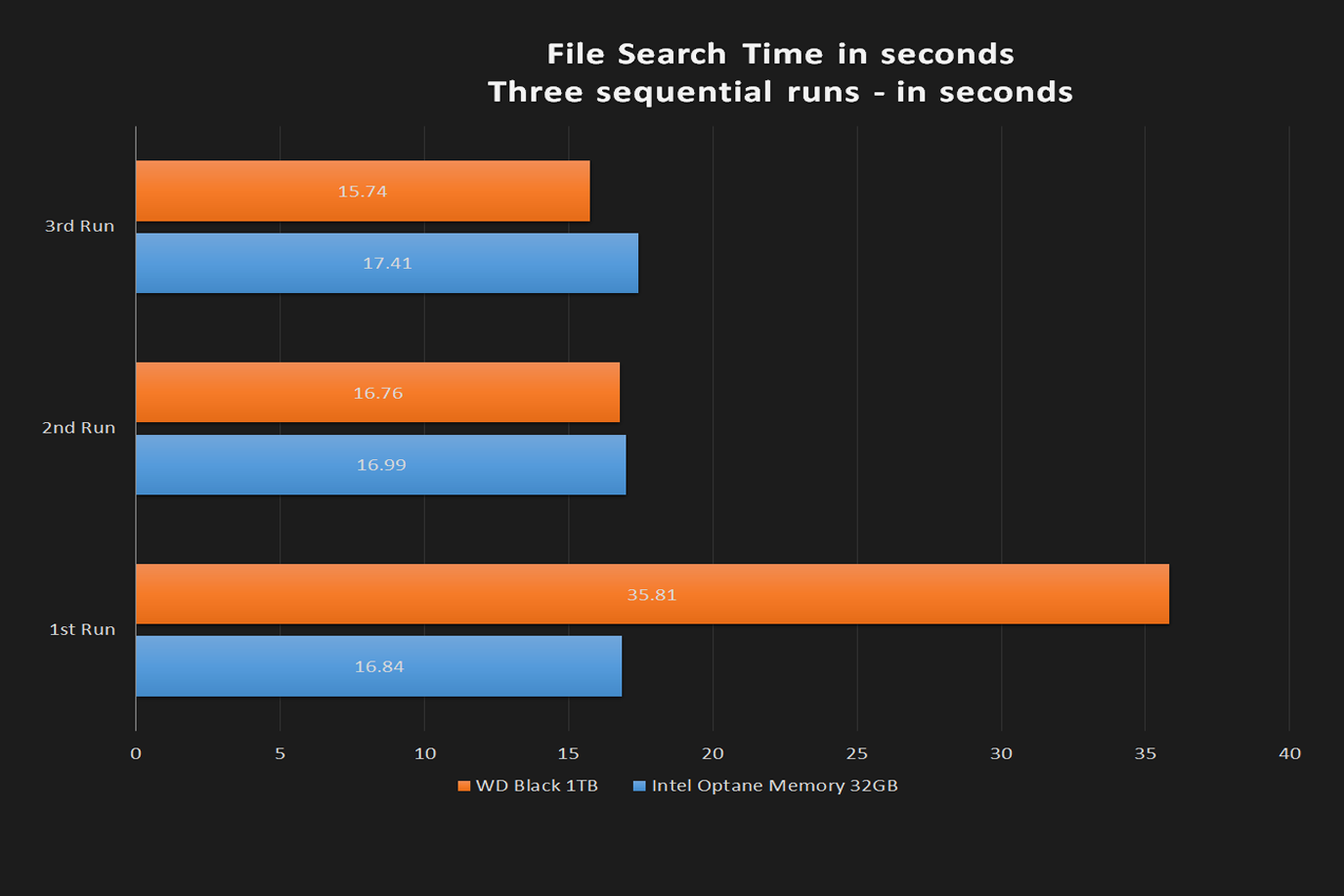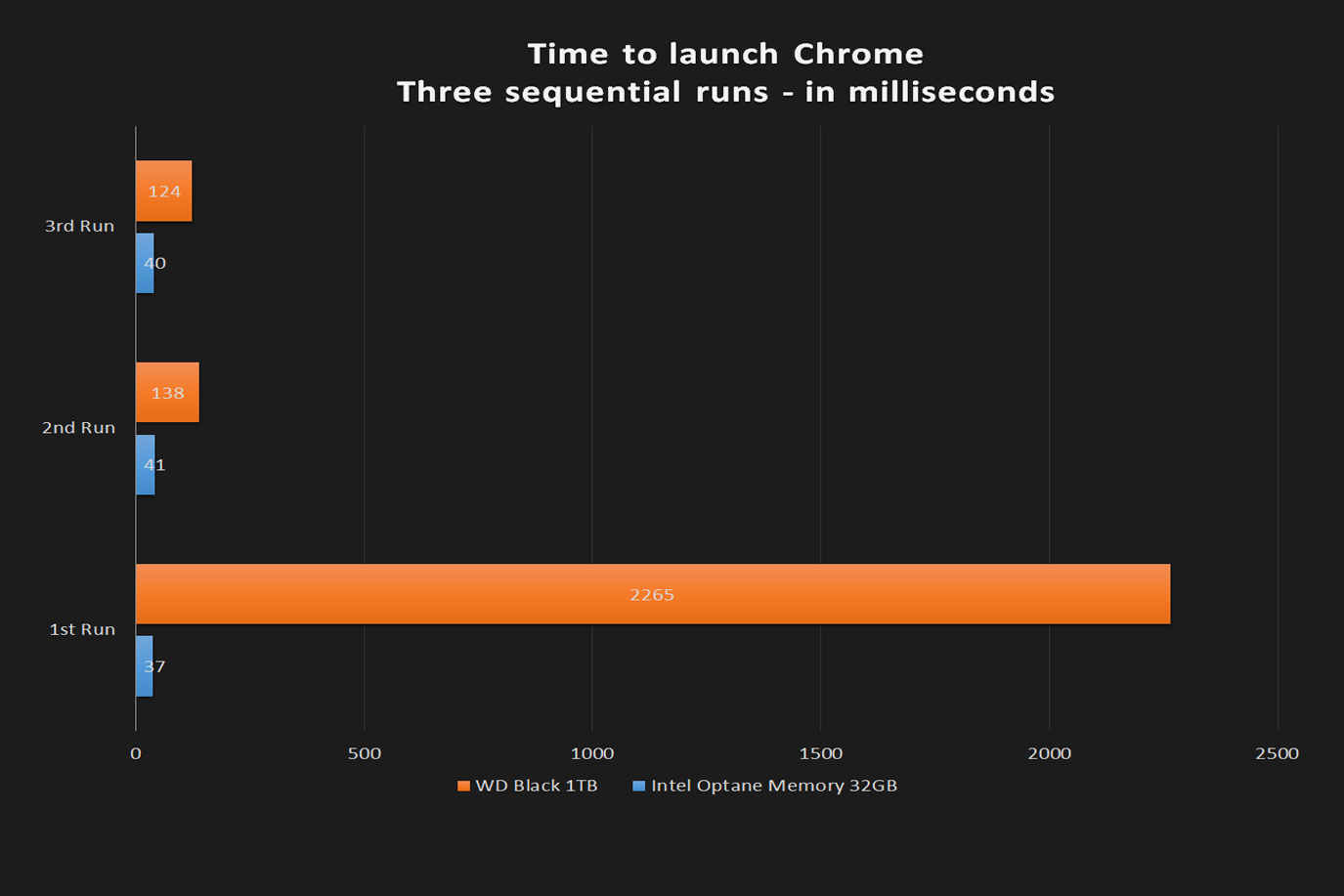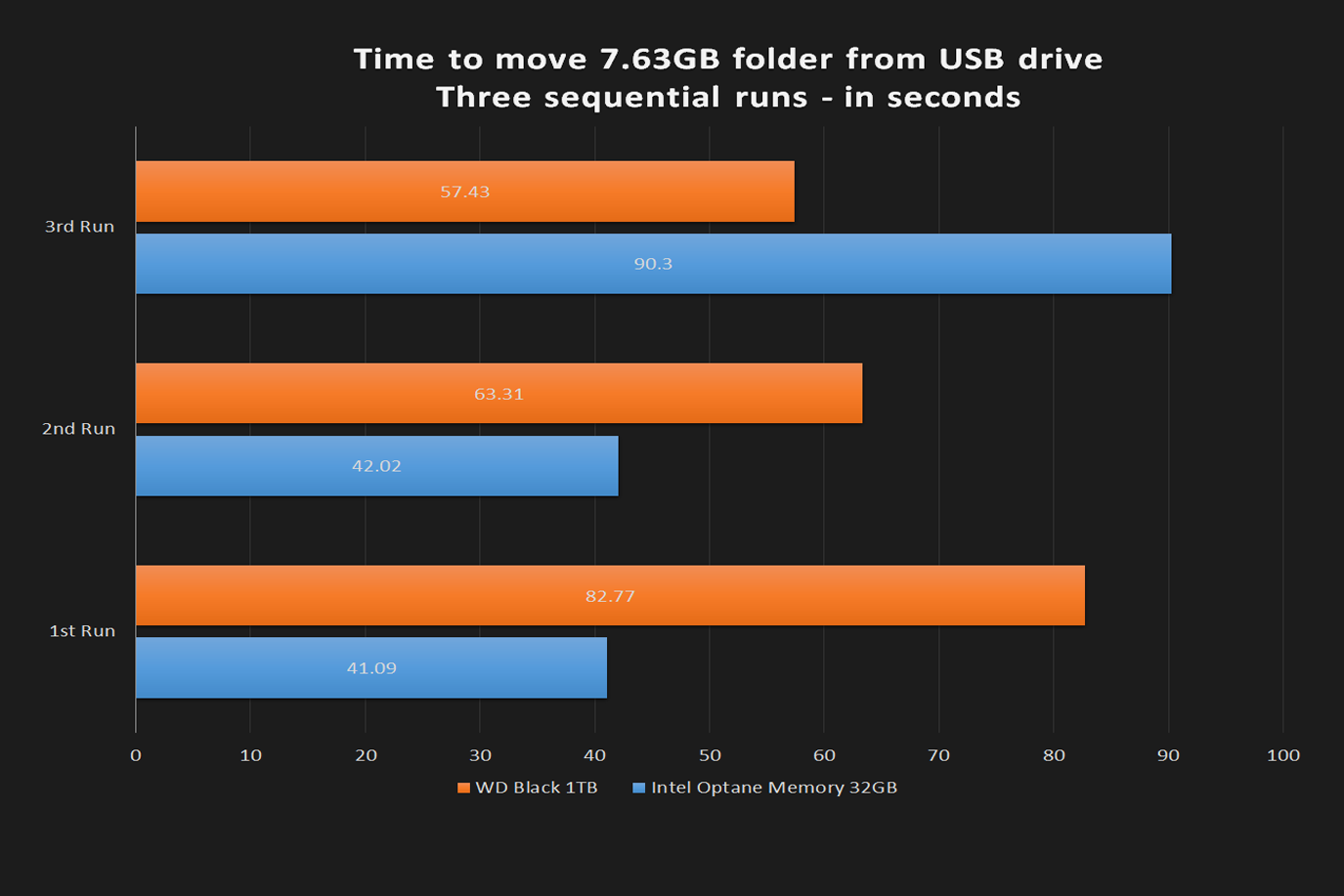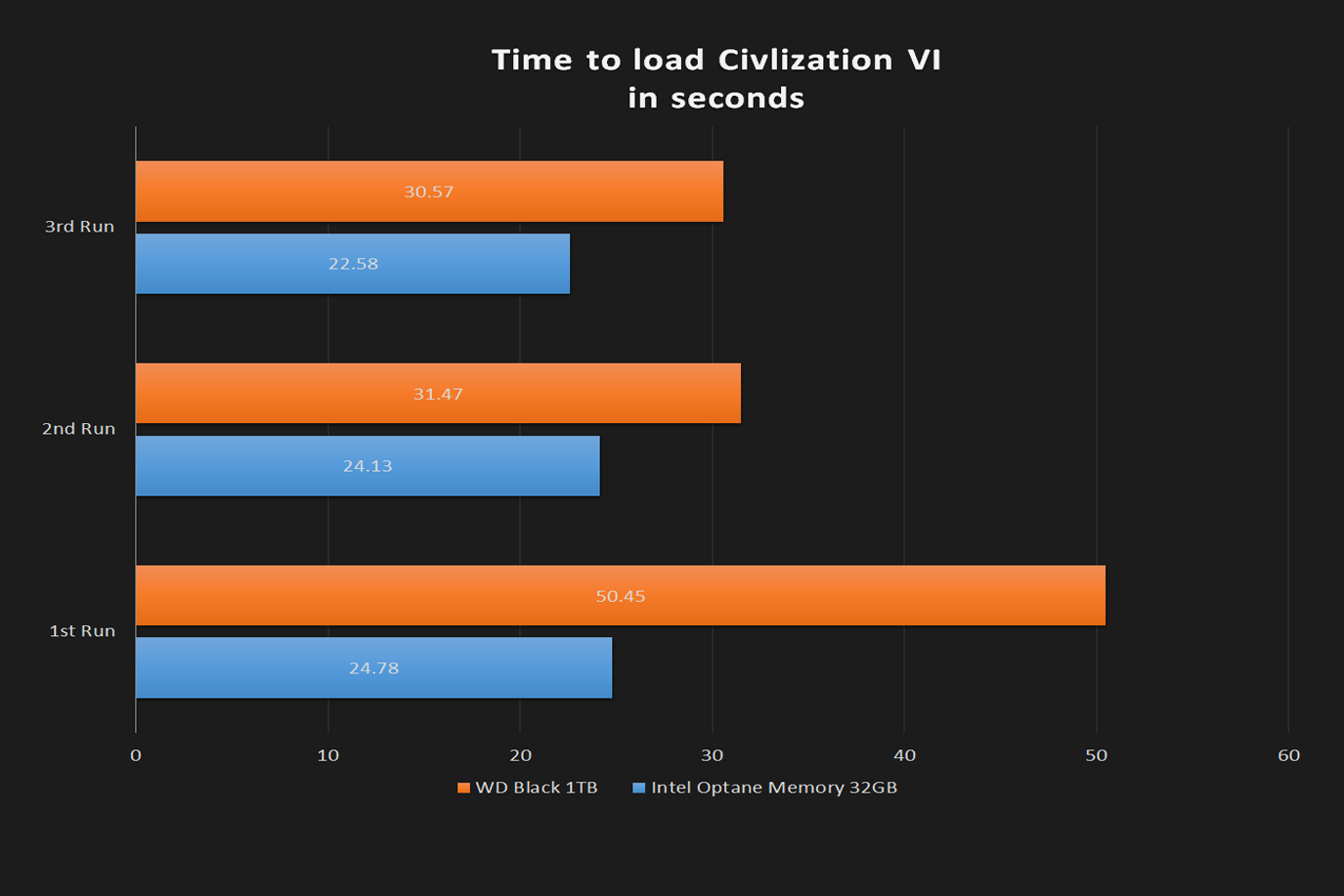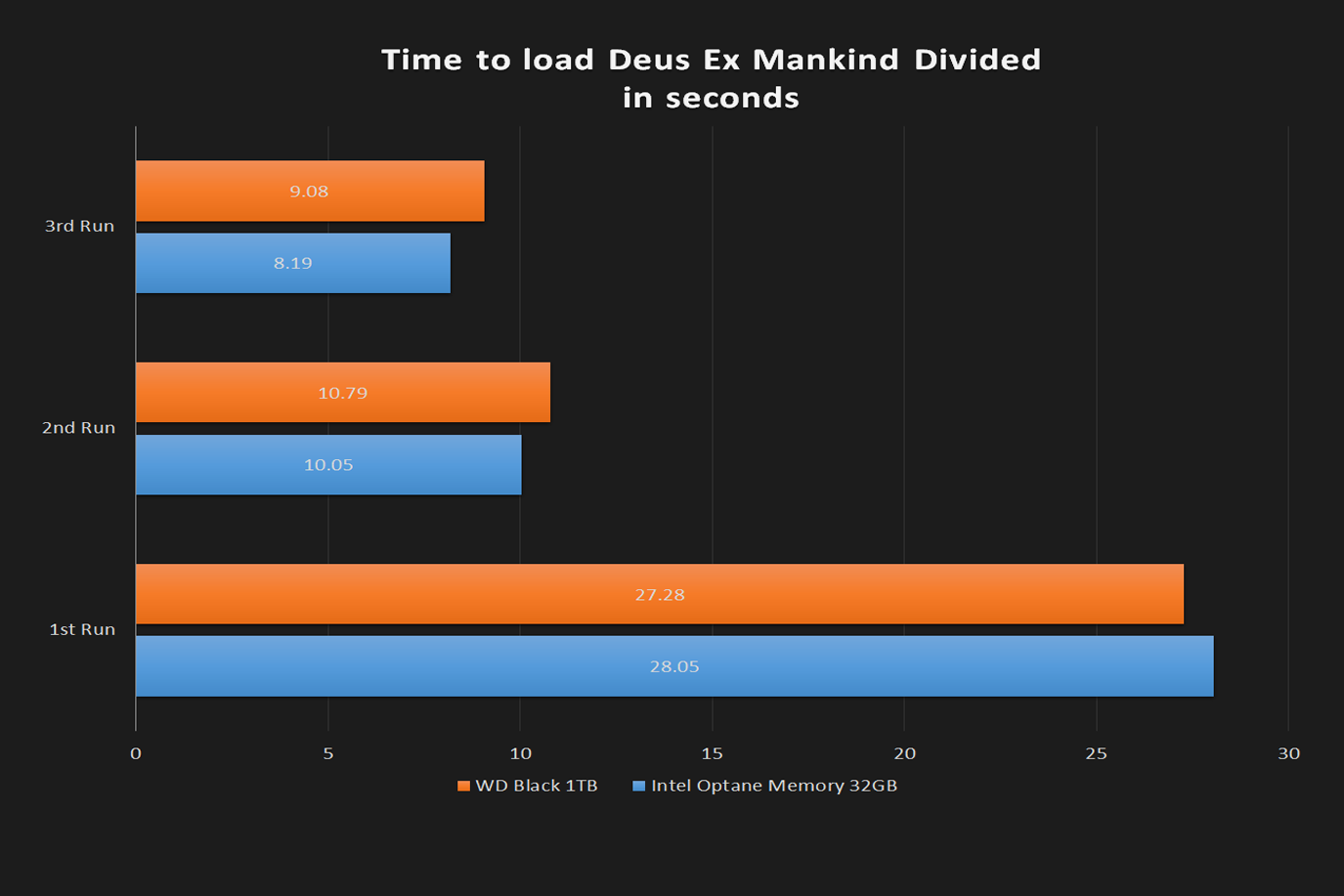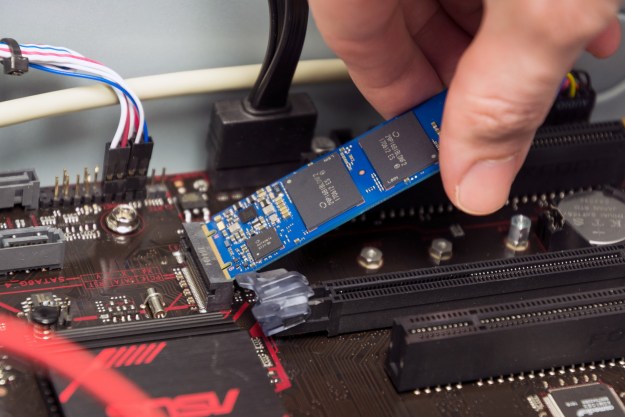
“Intel’s Optane Memory is affordable yet effective, but only works with the company’s newest processors.”
- Affordable pricing
- Strong real-world performance
- Consistently improves load times
- Five-year warranty
- Only works with latest Intel CPUs
- Doesn’t improve performance in all scenarios
- A dedicated SSD is better value
Intel Optane is here. First announced almost two years ago, Intel’s new storage technology proved elusive as anticipated dates slipped and speculation about problems circulated. Even now, it’s early days for the technology. Intel’s only stand-alone Optane drive, the DC 4800X, targets enterprise exclusively with a suggested retail price of $1,520 for 375GB of storage. If you can obtain one — it’s not sold through major online retailers.
That’s obviously not going to work for home users, but Intel didn’t want to leave them out. The company’s solution is a compromise. Instead of shipping an Optane Memory drive for home use, the company is selling a cache drive available in 16GB of 32GB capacities. They’re affordable, too, with MSRPs of $44 and $77, respectively.
Debuting at a low price is an interesting move, and contrary to how a tech giant like Intel would normally introduce cutting-edge hardware. Yet the tactic is also risky, because it positions Optane as an optional add-in rather than a straight replacement to a typical hard disk or solid state drive. Does the gamble pay off? Or does Optane Memory need more time in the oven?
What the cache?
Optane redefines cutting edge storage technology. It’s not based on the flash memory tech that powers modern solid state drives, and Intel hasn’t gone out of its way to reveal what makes Optane work. Yet Intel’s first consumer release of it, in the form of a cache drive, is a bit old-fashioned.
A cache drive is essentially a middle manager that sits between your PC’s RAM and a hard disk. Its goal is to queue up data that you’re likely to need so that it can be quickly accessed when requested. A handful of hard drives already use the same tactic (and have for years), although the cache in those drives was made up of traditional solid state memory, not Intel’s fancy new Optane hardware.
The Microsoft Surface Studio, for example, has a hard disk paired with between 64GB or 128GB of solid state storage, which is used as a cache. Seagate sells an entire line of ‘Desktop SSHD’ drives that pair a spinning disk with 8GB to 16GB of solid state storage, all in a traditional 3.5-inch internal hard drive chassis.
However, these solutions are pre-configured. Users usually can’t select the size of the cache, choose to turn it off, or later replace it with a better version while retaining the hard disk. Intel’s Optane Memory is an add-in solution that’s configurable, and targets enthusiasts who already have their own home-brew rig.
Very specific requirements
A drop-in Optane Memory cache drive would be an awesome solution for old PCs that already have a hard disk. Unfortunately, that’s not how it works.
While the Optane Memory module physically slots into the common M.2 slot, it’s only compatible with recent motherboards, such as the new B250 and Z270 series, along with Intel’s 7th-generation Core chip. Even the 6th-generation Intel Cores, and their companion 100-series chipsets, are not supported. AMD’s hardware, including Ryzen, is also excluded.
Optane redefines cutting edge storage technology.
That’s a bummer, as it greatly limits the target audience. The setup requirements might also befuddle users. While we were provided a fully built system for testing Optane Memory, we couldn’t help but notice a long list of instructions and preferred settings in Intel’s information sheet. The drive only works with the primary boot drive, and ties itself to the serial number of the boot drive when installed, meaning you’ll need to set the Optane Memory up again if you ever change your boot drive. A BIOS update and Optane drivers are also required.
Anyone looking to install Optane Memory will need to have a good understanding of PC hardware. It’s not as easy as installing a video card.
The test system
Intel provided a pre-built test system for review. It was configured with an Intel Core i5-7500 processor, an Asus Prime B250-Pro motherboard, and 16GB of DDR4-2400 RAM. The Intel Optane Memory 32GB module was paired with a Western Digital Black 1TB 3.5” SATA hard disk. It ran Windows 10 Pro 64-bit Anniversary Update.
We tested performance in the benchmarks below first with Optane Memory enabled, and then with it disabled. As you’ll see below, we ran most of the benchmarks several times in succession, to see how load times change as additional data is, or isn’t, cached into the drive.
CrystalDiskMark has good things to say
We start with CrystalDiskMark’s sequential read and write tests. This is the only test that we run on all system, from laptops to desktops to hard drives, so it provides a good relative sense of performance even if the benchmark doesn’t directly relate to a particular real-world use.
The benchmark comes out favorably for Optane Memory, particularly in read speeds. The sequential read numbers posted here are equivalent to a mid-range M.2 solid state drive like the Samsung PM951, which is common in laptops and off-the-shelf desktops.
A great deal of write performance is traded in return, but that’s not unusual. In fact, the 290 megabytes per second achieved with Optane Memory turned on is on par with entry-level solid state drives. These are solid scores.
Real-world testing with real-world results
CrystalDiskMark is only one benchmark, however. And a cache drive like Optane Memory is designed to make a hard disk feel like a solid state disk in normal, everyday tasks. To test that, we ran Optane through boot time, Windows 10 file search time, and Chrome launch time tests. We ran each test three times in a row.
All three tests produced similar results. Optane Memory grabbed a lead over the hard disk on the first run, with a margin of victory that ranged from huge to massive. The Chrome launch time task loaded 62 times more quickly on Optane than on the hard disk. Not bad!
However, the gains were almost completely negated in successive runs. Why? Well, Intel’s not the only one making smart use of data. Even normal hard disks have small caches. The WD Black 1TB drive in the Intel test rig has a 64 megabyte cache. In addition to that, Windows is always trying to make better use of data by keeping it active in system RAM rather than flushing it.
Those tactics mostly negated the advantage of Optane in successive runs. However, the value of fast first-run load times shouldn’t be understated. It contributes significantly to system feel. After all, how often do you open a program, close it, and then immediately open it again?
Transferring from an external drive nets interesting results
The real-world testing showed Optane Memory working as it should in the most predictable conditions. However, we were curious what might happen when moving files to or from the boot drive with Optane active. Will performance fall back to speeds limited by the hard disk it’s paired with, or will there still be some benefit?
These tests were performed with Samsung’s Portable SSD T1 1TB, one of the fastest USB drives available, over a USB 3.0 connection. We transferred a file containing Sid Meier’s Civilization VI, which weighed in at 7.63GB.
The results were varied. We did see a significant performance bump when moving files from a USB drive, but only in the first two runs. The third run was unusually slow. Curious, we rebooted and re-tested the system several times and found this general pattern to be repeatable. While the Optane Memory accelerated the first two file transfers, it often failed to handle the third, resulting in an unusually long file transfer time. It did on one occasion load quickly on the third try, too, but then loaded slowly on the fourth.
Results were more consistent with file transfer times from the test PC to the Samsung Portable SSD T1 1TB. Optane Memory was faster every time, but only by five or six seconds. It’d be difficult to notice the difference without a stopwatch.
On balance, Optane Memory didn’t offer much benefit when transferring files to or from a USB drive. It accelerated transfers in bursts, but eventually ended up close to the speed of the hard disk it was paired with. That makes sense. Data transferred from an external drive must eventually end up on the hard disk, so it will become the bottleneck.
Game Load tests
Intel, as part of its Optane Memory marketing push, is targeting gamers…sort of. The company has spoken about how it could benefit gamers, saying Optane Memory can launch games “up to 67 percent faster,” and load levels “up to 65 percent faster.” However, the company didn’t show us game-specific load times.
We decided to test using two games – Deus Ex Mankind Divided and Civilization VI.
As you can see, the results consist of one positive and one negative result. Deus Ex saw absolutely no noticeable benefit from Optane Memory. However, Civilization IV consistently loaded much more quickly. It was twice as quick as the hard disk on the first run, and seven to eight seconds quicker on later runs.
While Optane might help in select games, it may offer no help at all in others. That inconsistency makes it a no-go. As always, gamers are best served by purchasing the largest solid state drive they can afford.
But how does it feel?
The benchmarks we ran did show that Optane Memory provides the promised performance improvement when paired with a hard disk. Yet there’s more to it than numbers. While solid state drives provide amazing transfer speeds, it’s latency that makes them wonderful. Users have come to expect that a program or menu will open as soon as it’s clicked or tapped. Hard disks don’t react quickly enough.
The Chrome launch time task loaded 62 times faster on Optane than on the hard disk.
Optane Memory does. Its benefit was obvious from the moment we turned on the test rig. With Optane enabled the boot time was short, and the system was immediately responsive from the moment Windows 10’s desktop appeared. Without, the system felt hesitant. Even the Start Menu and Windows Explorer could take a second to respond. That may sound insignificant, but it’s rather frustrating.
However, its benefits are only up to those enjoyed by an entry-level solid state drive. It doesn’t feel slower, but it also doesn’t feel quicker. That’s no real surprise, and Intel never said Optane Memory can beat a solid state drive. Still, most enthusiasts now prefer using a solid state drive for a boot drive, and there’s nothing in Optane Memory that will lure them away from that solution.
Warranty information
Intel’s Optane Memory drive comes with a five-year warranty against manufacturer defect. This is a strong guarantee, and most users will probably upgrade to a different storage solution before the warranty term expires.
Our Take
Intel’s Optane memory successively accelerates storage for less than $100. Its performance benefit over a stand-alone hard disk ranges from reasonable to outstanding. More importantly, it makes a system with a hard disk behave as though it has a solid state drive in day-to-day use.
However, Optane is hampered by its restrictive system requirements. Though it would be a perfect upgrade for an older rig with a hard disk, it only works with new systems that have the latest Intel motherboards and processors. That puts Optane Memory in a tough spot.
Is there a better alternative?
This is where Intel’s Optane Memory gets into trouble. Our 32GB review model, priced at $77, performed well, but it must be paired with a hard disk. The WD Black 1TB drive in our test rig retails for $75. That puts the total price for storage just north of $150.
Solid state drives with 256GB of storage are often sold for $80 to $90. Those with 480GB to 525GB are sold for as little as $140. 1TB drives start at $250.
Optane Memory’s compatibility requirements mean it will only be interesting to enthusiasts who are building, or have just built, a new rig. Those enthusiasts will likely prefer using a solid state drive as the boot drive, rather than going with Optane Memory’s hybrid solution. Though slightly more expensive, it performs in all scenarios, and will be less hassle when it comes time to upgrade to a new drive.
How long will it last?
Intel provides a five-year warranty for Optane Memory, which is great. This is the first generation of a new technology, however, so current Optane Memory modules will become obsolete quickly. Stand-alone consumer Optane drives are likely to appear this year, as well, though pricing is anyone’s guess.
Should you buy it?
No. Intel Optane does what it says on the tin, but its restrictive compatibility, and the low pricing of current solid state drives, squeezes Optane out of recommendation territory.


